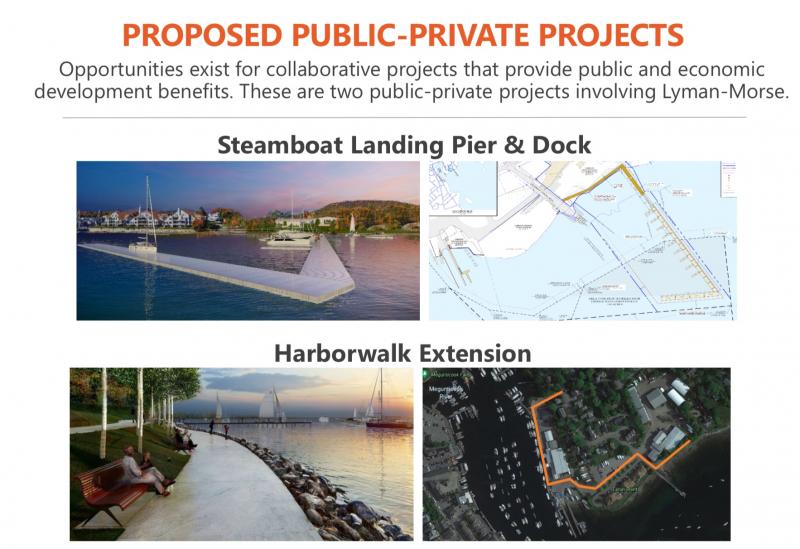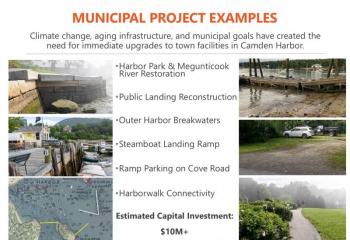CAMDEN — Informal conversations over the past few years periodically referenced a new marina visualized for Steamboat Landing, in Camden Harbor. On March 9, the idea took public form when Lyman-Morse, the privately owned boatyard on the east side of the harbor, unveiled its plans to the Camden Select Board, proposing a $30 million public-private venture that would change the shoreline of the town’s inner, as well as outer, harbor.
It is an ambitious endeavor, but could incorporate, as Town Manager Audra Caler said at the meeting, some of the town’s own municipal goals.
“It is a really big project but has the potential to be a great partnership that allows us to achieve a lot of the goals that the Select Board has outlined,” she said, at the meeting. “If we do this correctly, it’s not just about Lyman-Morse and their project. It’s about all the private property owners around the harbor and trying to incentivize them to be able to make the changes that they are going to need to make for the town to be sustainable into the future.”
The project is in addition to another Lyman-Morse construction job already underway.
Just three months ago, in early December 2020, the Camden Planning Board approved a large-scale rebuild of the Lyman-Morse boatyard on the inner harbor after buildings there were partially destroyed in June 2020 during a restaurant fire.
In total, Lyman-Morse owns approximately 3 acres of Camden harborfront land. In addition to the inner harbor property, Lyman-Morse also owns the Bean Yard, a large lot abutting the publicly owned Steamboat Landing, near Eaton Avenue and a residential neighborhood.
That’s the focus area for the boatyard’s next major upgrade, and the company wants to include the Town of Camden in its funding and execution.
With the proposed construction of marina infrastructure, and a harbor walk, Lyman-Morse is hoping the town will kick in $10 million toward the $30 million total cost.
The inception
Lyman-Morse Boatbuilding Inc., with headquarters in Thomaston, acquired the Camden boatyard, formerly known as Wayfarer Marine, in 2015. With the purchase, Lyman-Morse refocused the Camden yard business, which had been drifting toward the real estate development of its three acres, back onto boats.
In 2015, owner Cabot Lyman said: “We’re boat people. We’re not trying to do anything else but act as a marine service.”
As for real estate development, “We’re not doing that,” he had said.
At the March 9, 2021 Camden Select Board meeting, both Drew Lyman, who heads up the Camden division of Lyman-Morse, and Josh Moore, project manager with the company, cited two factors propelling the boatbuilding company to a conversation with the Select Board this winter:
1) In early 2020, Lyman-Morse received a $1.5 million federal grant to construct and install in Camden a 120-foot fixed pier, a 334-foot wave-attenuating floating dock, a 579-foot floating dock, and 16 slips for other transient vessels, providing a total of 2,000 linear feet of new dockage for eligible transient boaters.
While the specifications have changed now to include a 148-foot fixed pier, a 267-foot dock, a 539-foot dock with finger docks for yachts, a 325-foot public walkway along the shore, and a 1,400-foot boardwalk, with pedestrian access to Eaton Ave., there remains a looming deadline that requires Lyman-Morse to get agreements at least signed prior to September.
2) The yachting market is growing after the Great Recession and Camden is part of the transient yachting circuit that weaves along Maine’s coastline, from Portland through Penobscot Bay.
Moore told the Select Board that Belfast and Rockland are making improvements to their harbors, “and if we want to stay on the circuit, we have to, as well.”
But, the inner harbor is too tight for large boats, and it is full most of the time, said Moore.
Camden is already running at full capacity 75 percent of season, and fitting more visiting boats into the harbor is difficult.
Many of the vessels have deep drafts that require more bottom room than the 10-foot depth the inner harbor provides.
The Bean Yard and Steamboat Landing, on the other hand, front the outer harbor, which offers deeper water, “with no initial dredging required,” the boatyard said.
Citing Marine Industries Association of South Florida data, Lyman-Morse said the daily average expenditure by transient yachts of a length of 40-plus feet is $275.
That further breaks down, Lyman-Morse said, to dollars spent:
Fuel: $58
Restaurants and bars: $47
Groceries: $39
Lodging: $61
Each visiting yacht directly supports 11 full-time jobs, the company said, and each yacht produces nearly $150,000 of state and local tax revenue.
Lyman-Morse told the board that the company anticipates hiring 25 to 35 more employees with the development, and said there could an additional 20 to 30 non-Lyman-Morse jobs created.
Project elements: Harborwalk, new pier, dock
With the proposed harbor construction, Lyman-Morse hopes to relieve boat congestion in the inner harbor, and address climate change effects, including the better protection of the public Steamboat Landing launch.
It will, in collaboration with Camden, aim to build:
148-foot piling supported fixed pier with an 80-foot ADA-compliant gangway. The pier would be owned by the town and operated by Lyman-Morse;
167-foot wave attenuating floating dock
539-foot floating dock with side-tie dockage and 9x40-foot finger docks for yachts
325-foot elevated shoreside public walkway on the outer harbor with seating for harbor views
1,400-foot boardwalk and ADA compliant pedestrian pathway through Lyman-Morse inner harbor boatyard
Funding and taxpayer collaboration
To embark on the project, Lyman-Morse is suggesting the town revise its tax increment financing district to accommodate the Bean Yard and Steamboat Landing. This fiscal development requires more details that have yet to be outlined, and would ultimately require voter approval.
Moore said the town and boatyard could leverage its grant to get started, and leverage private funding, but need the Select Board to act to get plans before the voters this coming summer.
The project is several years away from construction, he said, but the terms of the grant must be executed by September.
Camden, meanwhile, must address its approach to accommodating not only the financial mechanics, but the public process timeline, and the accompanying load on municipal staff time.
Caler said after the meeting on March 12 that she will talk with the town’s planner, Jeremy Martin, and municipal Attorney Bill Kelly to map out:
• What the town is going to need to do in terms of a public process;
• Determine who is responsible for making recommendations and/or decisions at each stage of the process (i.e. Harbor Committee, CEDAC, Planning Board, Select Board, Town Meeting);
• Identify what the town’s opportunities are for using the project to leverage funding or other resources that will help progress goals that the Select Board and Town have identified; and,
• Identify issues this project may pose to the town in progressing its goals.
”Once we've had a chance to do this, I need to circle back to the Select Board to make sure they are comfortable with the process and give them the opportunity to make changes,” she said.
While the Select Board, at its March 9 meeting, supported the concept, they were likewise protective of town staff time, and expressed concerns about large tourist boats inundating the harbor.
At the March 9 meeting, Select Board member Jenna Lookner asked Moore and Lyman what they hoped the outcome of their meeting with the Select Board would be.
“We need to get started,” said Moore. “We wanted to bring it to you. The process starts with you.”
He referenced the many logistical and procedural pieces.
“What we need from you is the green light,” he said.
Board member Taylor Benzie asked: “Where do you need to be by September?”
“We need to have all our agreements, how we are going to move forward with the project, finalized by that point,” Moore said.
Board member Alison McKellar noted how short the procedural timeline was for placing any additional articles on the June Town Meeting warrrant.
Caler said that there would be “no way to make it on June ballot, it would have to be a special town meeting.”
Martin said that should the project become, “a real public/private project, we are going to start process that quickly.”
Lookner commented that Lyman-Morse was, “asking for a blessing and staff time.”
She continued: “As a board, we need to acknowledge the amount of staff established and not run away with town staff. We want to make sure everyone feels OK about that.”
Benzie said he supported the concept, acknowledging the, “investments into harbors north and south of us.”
McKellar cautioned the project proponents that the climate change benefits needed clarifying, and referenced the harbor walk, as designed, includes, “a lot of shoreline armor, impervious surface in a walking path.”
Martin said the process moving ahead would have to be public.
“You can be assured this is going to happen,” he said. “Lyman-Morse has their act together to move this forward.”
Reach Editorial Director Lynda Clancy at lyndaclancy@penbaypilot.com; 207-706-6657

































